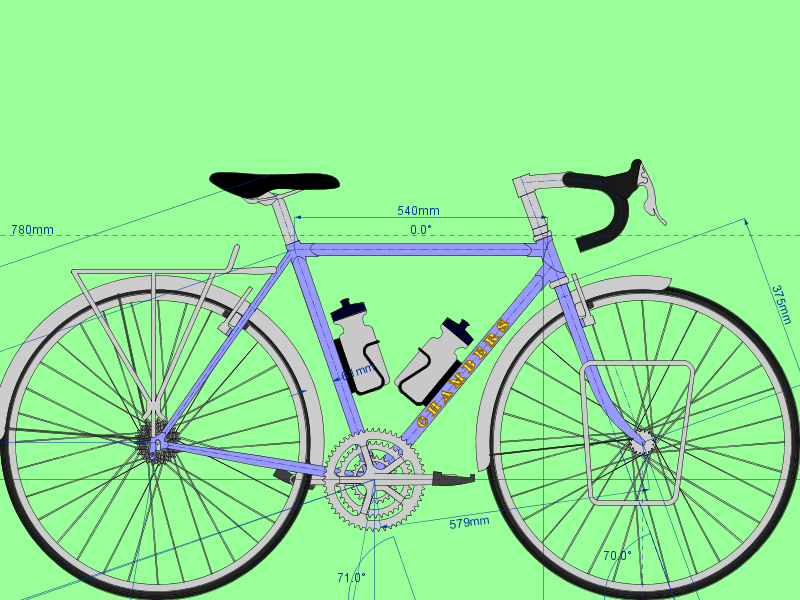Chambers Camarade (Model year: 2012)

| / Download BCAD file / | Get embed code |
CHAMBERS CAMARADE. With the potential for spending all day in the saddle, it is important for a touring bicycle to provide a comfortable ride. An ideal touring frame has the following characteristics: 1. COMFORTABLE RIDING POSITION. Compared to a racing cyclist, a touring cyclist will want (i) a more upright position that enables a better view of the scenery, (ii) to pedal in the seated position virtually the whole time, and (iii) gentler steering properties that primarily depend upon handlebar movements rather than subtle shifts in shoulder position or weight distribution. Less steep steering tube and seat tube angles allow for a more upright seating position. As well as improving the general view, this results in less body weight being transmitted through the handlebars. The gentler steering tube angle also places the hub of the front wheel marginally further in front of the steering column and this makes the bike less sensitive to small adjustments in handlebar position. A saddle positioned further behind the bottom bracket reduces the tendency to stand up whilst pedalling. 2. GOOD ROAD SHOCK ABSORPTION. A touring cyclist who spends all day in the saddle does not want to be jarred by every bump on the road. Longer chainstays, typically about 47cm long, help to absorb much of this unwanted energy. 3. SMOOTH HANDLING CHARACTERISTICS. Whilst a racing cyclist wants a frame with highly sensitive and responsive steering properties, touring cyclists do not want to be constantly correcting the direction of travel. They want their bike to keep going in a straight line by default, except when they deliberately enter into a turn. In addition to the steering tube angle considerations described above, the desired handling properties are achieved by lengthening the wheelbase. The increased chainstay length contributes to this, as does paying greater attention to achieving a front-centre distance of about 58cm. in this small frame. 4. CARRYING POTENTIAL, MUDGUARDS AND DRINK BOTTLES. Touring cyclists generally travel with luggage. They do not want to get any wetter than necessary in the rain. As weight-reduction is not such an important consideration, various additional items become important considerations. These might include water bottle holders, pump holders, spare spoke holders, etc. 5. LOWER CENTRE OF GRAVITY. Anything that lowers the centre of gravity of the bike will help to improve its stability. One means of achieving this is to position the bottom bracket closer to the ground. In order to prevent the pedals from striking the ground whilst cornering, touring cyclists do not lean into the corners so much and they generally coast round with a suitably positioned inside pedal. 6. WIDER GEAR RATIOS. Touring cyclists are less interested in speed. They want to work aerobically as much as possible, even up steep hills. They generally have a wider range of gear ratios, with greater emphasis at the easier end of the gear spectrum. Triple front chainrings are quite common. The bicycle shown has been designed for a rider with a 78cm inside leg. It is a one-off build.


